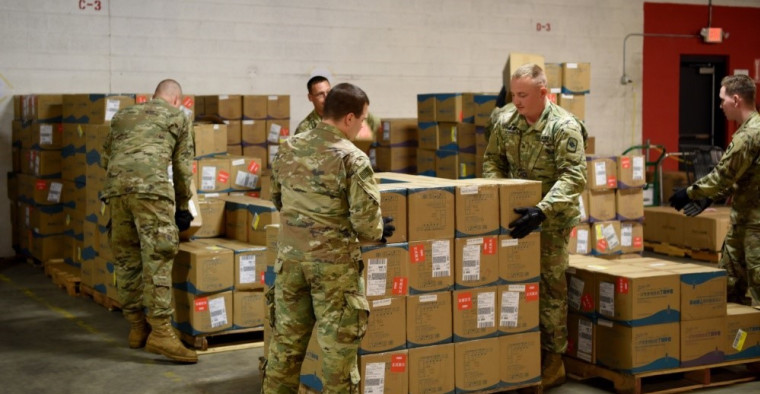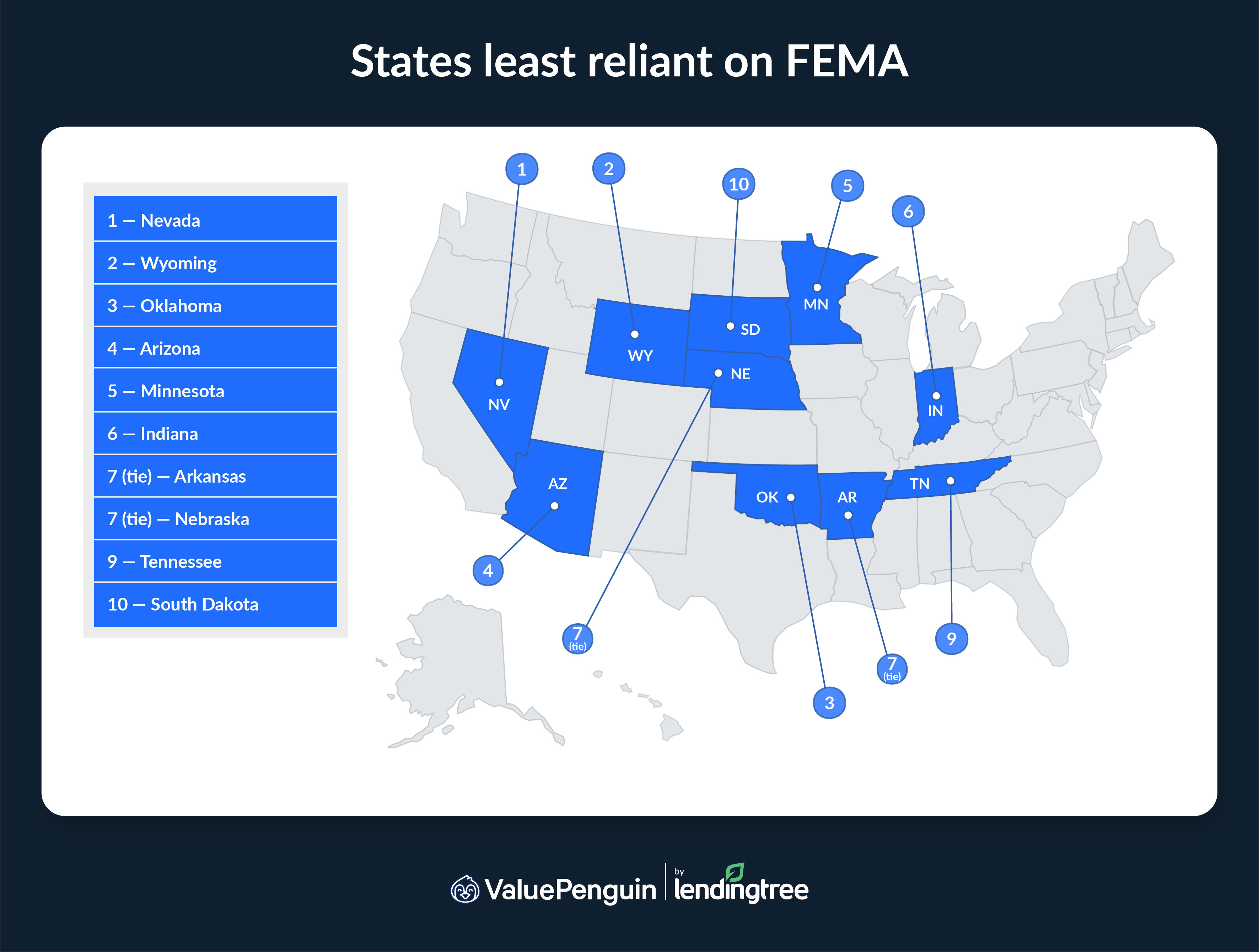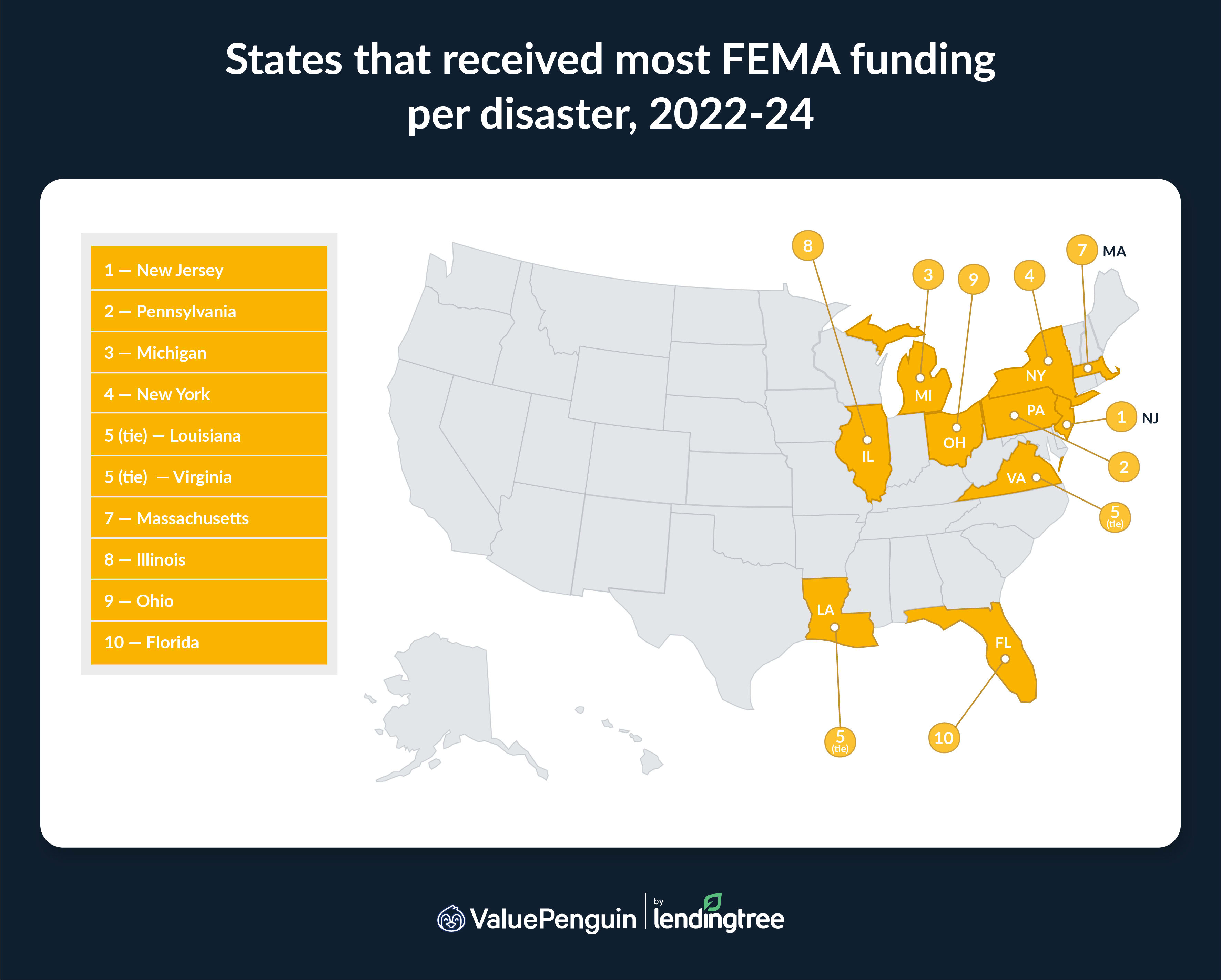Homeowners Insurance
East Coast States the Most Reliant on FEMA

The Federal Emergency Management Agency (FEMA) was created decades ago to consolidate and streamline the federal government's response to disasters, but the current presidential administration hopes to dissolve it — a move that could prove disastrous for some states.
In this study, we looked at FEMA spending per state from 2022 through 2024. Specifically, we calculated the average amount of FEMA funding per person and disaster, as well as obligations (more on this soon) as a share of state spending.
Here’s what we found.
On this page
- Key findings
- FEMA obligations account for average of 1.19% of state spending
- East Coast states are particularly reliant on FEMA
- Nevada is the least reliant
- New Jersey received $3.8 billion in FEMA funds for 1 disaster
- FEMA obligations rise to over 5.00% in 1 state
- Preparing for disasters: Top expert tips for homeowners
- Methodology
Key findings
- States receive an average of $341 in Federal Emergency Management Agency (FEMA) funding per person and $438.2 million per disaster, while obligations account for 1.19% of states’ spending. These averages vary widely, with some states seeing over $1,500 in funding per person, billions in funding per disaster or more than 5.00% for obligations as a percentage of spending.
- East Coast states are the most reliant on FEMA. Of the 10 most reliant states, seven are on the East Coast. But Louisiana — the most reliant — has the highest FEMA funding per person ($1,564) and the highest FEMA obligations as a percentage of state funding (5.58%). It also has the fifth-highest funding per disaster ($1.0 billion). New York and Florida are the next most reliant.
- Nevada, Wyoming and Oklahoma are the least reliant on FEMA. Specifically, Nevada gets the second-least per capita from FEMA at $72. Each of these states finishes in the bottom 10 in every metric — the only ones to do so.
- New Jersey received the most in FEMA funds per disaster. New Jersey only had one disaster declared from 2022 through 2024, but it was a costly $3.8 billion. Pennsylvania and Michigan also saw only one disaster during this period that was similarly costly, at $2.4 billion and $1.6 billion, respectively. The highest state with multiple disasters was New York — with 11, at $1.5 billion per disaster.
- Louisiana, Florida and Montana have the highest FEMA obligations as a percentage of state spending. Louisiana is at 5.58%, with Florida (4.39%) and Montana (3.91%) trailing. New York (2.44%) and Vermont (2.14%) are the only other states higher than 2.00%.
What are FEMA obligations?
An obligation is a binding agreement that the U.S. government enters into when awarding funding. FEMA incurs an obligation when it places an order, signs a contract, awards a grant, purchases a service or takes other actions that require it to make a payment. When our study cites funding, we’re referencing obligations.
FEMA funding comes in different forms. While it isn’t part of a budget plan, emergency spending from FEMA is accounted for in a state’s fiscal spending report. FEMA provides funds in two major ways:
- Government funding: FEMA’s Public Assistance (PA) program provides supplemental grants to governments and some nonprofits so communities can quickly respond to and recover from major disasters or emergencies.
- People and businesses: FEMA’s Individual Assistance (IA) provides relief directly to survivors to assist those who have uninsured or underinsured necessary expenses and serious needs.
To determine FEMA obligations as a percentage of state spending, we used expenditure data for fiscal years 2022 and 2023 and estimates for fiscal year 2024.
FEMA obligations account for average of 1.19% of state spending
On average, states received $341 in FEMA funding per person and $438.2 million per disaster from 2022 through 2024. In the same general period, funding obligations accounted for 1.19% of states’ spending across the nation.
Note: Fiscal years vary by state, impacting timelines on our state spending data. The state fiscal year begins on July 1 and ends on June 30 in 46 states. Meanwhile, the fiscal year begins on April 1 in New York, Sept. 1 in Texas and Oct. 1 in Alabama and Michigan.
ValuePenguin home insurance expert and licensed insurance agent Rob Bhatt says those figures are concerning given the current administration’s goals for FEMA.
"We've seen an ongoing increase in the frequency and severity of natural disasters over the past two decades," he says. "Most states don't have the financial resources to entirely cover the escalating costs of rebuilding after a disaster on their own. Cutting back FEMA or phasing it out is ultimately going to reduce the financial resources that individuals and local governments have to rebuild after future disasters."
Averages for the three metrics we considered vary widely by state. Let’s break it down.
East Coast states are particularly reliant on FEMA
When it comes to the states that receive the most in FEMA funds, the majority are on the East Coast. Of the 10 most reliant states, seven lie along the Eastern Seaboard.
That’s largely due to the disasters that threaten these states.
"Gulf and Atlantic Coast states have large numbers of people living in areas exposed to severe weather," Bhatt says. "The harshest effects of hurricanes and tropical storms usually occur when they reach land. However, the remnants of these storms are also causing widespread destruction as they continue up the Eastern Seaboard and impact densely populated areas."
Still, the top state in terms of FEMA reliance is Louisiana. Most notably, it had the highest FEMA funding per person at a whopping $1,564 in the 2022-through-2024 period examined. It also has the highest FEMA obligations as a percentage of state funding (5.58%).

Louisiana also has the fifth-highest funding per disaster ($1.0 billion).
New York is the next most reliant, ranking fourth across each of the metrics analyzed, with an average of $802 in FEMA funding per person, $1.5 billion in funding per disaster and 2.44% in FEMA obligations as a percentage of state funding.
Florida ranks next. Of note, it has the second-highest FEMA obligations as a percentage of state funding (4.39%), sixth-highest per-person funding ($694) and 10th-highest per-disaster funding ($747.8 million).
Nevada is the least reliant
Conversely, Nevada is the least reliant on FEMA. Specifically, Nevada gets the second-least per capita from FEMA at just $72. It also has the third-lowest funding per disaster at $28.0 million and the fifth-lowest obligations as a percentage of funding at 0.41%.

Wyoming follows. It has the lowest per-disaster funding among states with declared disasters ($12.3 million) and ranks seventh-lowest in obligations as a percentage of funding (0.48%) and per-capita FEMA spending ($128).
Oklahoma rounds out the bottom three, with the fourth-lowest per-disaster funding ($32.3 million), fifth-lowest per-capita funding ($122) and eighth-lowest obligations as a percentage of funding (0.58%).
Full rankings: States most/least dependent on FEMA funding, 2022-24
Rank | State | FEMA funding per person | FEMA funding per disaster | FEMA obligations as % of spending |
|---|---|---|---|---|
| 1 | Louisiana | $1,564 | $1.0B | 5.58% |
| 2 | New York | $802 | $1.5B | 2.44% |
| 3 | Florida | $694 | $747.8M | 4.39% |
| 4 | Virginia | $476 | $1.0B | 1.72% |
| 5 | New Jersey | $405 | $3.8B | 1.38% |
| 6 | Montana | $1,054 | $142.9M | 3.91% |
| 7 | Connecticut | $516 | $465.4M | 1.46% |
| 8 | Massachusetts | $403 | $943.9M | 1.19% |
| 9 | Colorado | $307 | $443.3M | 1.58% |
| 9 | Rhode Island | $613 | $134.6M | 1.70% |
| 11 | Hawaii | $639 | $116.3M | 1.60% |
| 11 | Alaska | $1,081 | $61.0M | 1.71% |
Source: ValuePenguin analysis of USASpending.gov, Federal Emergency Management Agency (FEMA) and National Association of State Budget Officers (NASBO) data. Notes: State expenditures cover fiscal years 2022 and 2023 and estimates for fiscal year 2024. States were ranked based on unrounded figures for the individual metrics. Delaware, Maryland and Wisconsin had no disasters declared in the analyzed period, so they were ranked based on their averages for the other metrics.
New Jersey received $3.8 billion in FEMA funds for 1 disaster
During the studied period, New Jersey received the most in FEMA funds per disaster at a whopping $3.8 billion — though it was only for one disaster. The state declared a disaster for severe storms and flooding in July 2023.

Pennsylvania and Michigan followed, each with only one disaster during this period as well. While Pennsylvania received $2.4 billion, Michigan received $1.6 billion. Pennsylvania declared a disaster for Tropical Storm Debby in August 2024, while Michigan declared a disaster for severe storms, tornadoes and flooding in August 2023.
The highest state with multiple disasters was New York — which had 11 disasters and received $1.5 billion per disaster.
Full rankings: States with highest/lowest FEMA funding per disaster, 2022-24
Rank | State | Obligations | Disaster declarations | Funding per disaster |
|---|---|---|---|---|
| 1 | New Jersey | $3.8B | 1 | $3.8B |
| 2 | Pennsylvania | $2.4B | 1 | $2.4B |
| 3 | Michigan | $1.6B | 1 | $1.6B |
| 4 | New York | $16.2B | 11 | $1.5B |
| 5 | Louisiana | $7.3B | 7 | $1.0B |
| 6 | Virginia | $4.1B | 4 | $1.0B |
| 7 | Massachusetts | $2.8B | 3 | $943.9M |
| 8 | Illinois | $3.5B | 4 | $884.2M |
| 9 | Ohio | $865.5M | 1 | $865.5M |
| 10 | Florida | $15.0B | 20 | $747.8M |
| 11 | North Carolina | $2.7B | 5 | $547.2M |
| 12 | Connecticut | $1.9B | 4 | $465.4M |
Source: ValuePenguin analysis of USASpending.gov and FEMA data. Notes: Delaware, Maryland and Wisconsin had no disasters declared in the analyzed period. States were ranked for per-disaster funding based on unrounded figures.
FEMA obligations rise to over 5.00% in 1 state
Louisiana has the highest FEMA obligations as a percentage of state spending at 5.58%. As a coastal state, Louisiana is prone to hurricanes and tropical storms, for which it often receives FEMA funding. (Reminder: The total state expenditures data covers fiscal years 2022 and 2023 and estimates for fiscal year 2024.)
Florida (4.39%) and Montana (3.91%) follow. Like Louisiana, Florida is a coastal state prone to hurricanes and storms, and FEMA often provides relief for these major disasters in the region.

New York (2.44%) and Vermont (2.14%) are the only other states higher than 2.00%.
Full rankings: States with highest/lowest FEMA obligations as percentage of state spending, 2022-24
Rank | State | Obligations | Total state expenditures | Obligations as % of spending |
|---|---|---|---|---|
| 1 | Louisiana | $7.3B | $130.5B | 5.58% |
| 2 | Florida | $15.0B | $340.9B | 4.39% |
| 3 | Montana | $1.1B | $29.2B | 3.91% |
| 4 | New York | $16.2B | $664.7B | 2.44% |
| 5 | Vermont | $509.8M | $23.9B | 2.14% |
| 6 | Virginia | $4.1B | $238.9B | 1.72% |
| 7 | Alaska | $793.0M | $46.4B | 1.71% |
| 8 | Rhode Island | $672.9M | $39.7B | 1.70% |
| 9 | Hawaii | $930.3M | $58.2B | 1.60% |
| 10 | Colorado | $1.8B | $112.3B | 1.58% |
| 11 | Connecticut | $1.9B | $127.8B | 1.46% |
| 12 | North Carolina | $2.7B | $196.4B | 1.39% |
Source: ValuePenguin analysis of USASpending.gov and NASBO data. Notes: State expenditures cover fiscal years 2022 and 2023 and estimates for fiscal year 2024. States were ranked based on unrounded figures.
Preparing for disasters: Top expert tips for homeowners
Bhatt believes FEMA cutbacks could pose serious problems for flood insurance accessibility.
"Under current federal law, lenders have to make you get flood insurance for a home in a FEMA-designated high-risk flood zone," he says. "Eliminating FEMA would put the National Flood Insurance Program (NFIP) in jeopardy. This, in turn, could upend the process of buying and selling homes in flood-prone areas, including many coastal regions."
In general, FEMA assistance has been a valuable backstop for uninsured and underinsured losses. "Now that this backstop may be going away or scaled back, it's more important than ever to make sure you have financial protection from the risks in your area," Bhatt says. "Homeowners insurance usually includes funds to stabilize your home and temporary living expenses after a covered disaster."
Here’s what he recommends:
- Determine what your insurance already covers. "Homeowners insurance usually covers fire, wind and hailstorms, but you need separate windstorm coverage in some areas exposed to severe coastal weather," he says. "Homeowners insurance doesn’t cover floods or earthquakes, but you can purchase separate insurance to protect against these risks."
- Determine your flood risk, even if you don’t think you need to worry about it. "It's especially important to pay attention to the flood risks in your area," he says. "Floods can happen just about anywhere, and flood damage is difficult and expensive to repair."
- Minimize the potential damage a natural disaster can cause to your home. "Wind-resistant roofing and windows are good investments in areas with hurricanes, tornadoes and windstorms," he says. "Consider noncombustible roofing and other fireproof materials if you're in an area with wildfire risks. In low-lying areas, you can elevate essential appliances like your HVAC and water heater to a higher floor and install flood vents to reduce potential damage from flooding."
Methodology
ValuePenguin researchers analyzed Federal Emergency Management Agency (FEMA) data using various sources to create a composite ranking of the states most dependent on funding. Each category evaluated was given an equal weight. The three categories were:
- FEMA funding per person, 2022-24
- FEMA funding per disaster, 2022-24
- Obligations as a percentage of spending, 2022-24
Total FEMA obligations by state and per capita are via USASpending.gov. Disaster declaration data is via FEMA. Per-disaster funding was calculated by dividing the total obligations for each state by the number of disasters in that state from 2022 through 2024.
